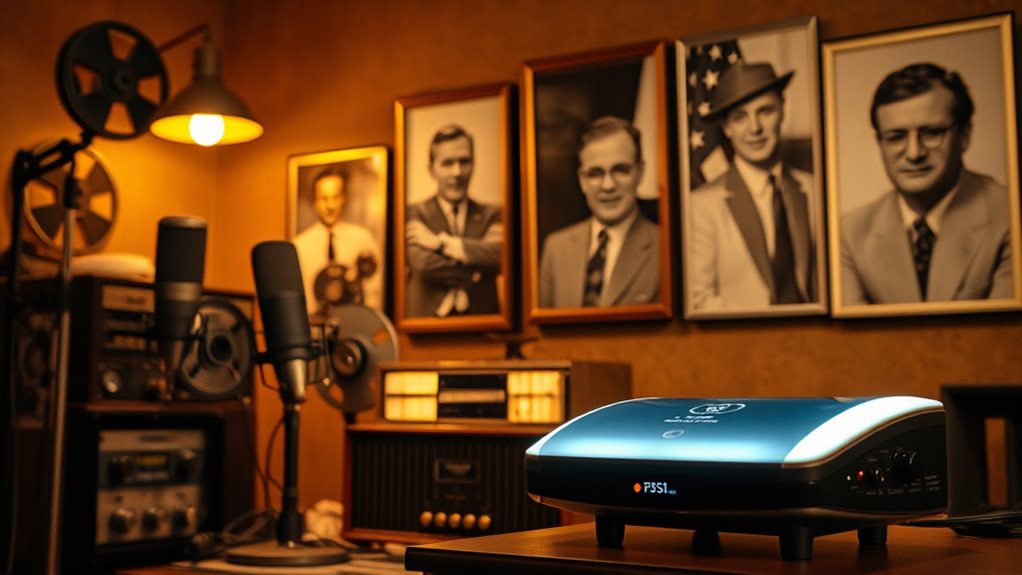AI voice cloning revives historic commentaries by creating realistic, immersive audio of legendary voices. It analyzes vast audio data to capture subtle nuances like tone, pitch, and emotional inflections, making the recreated voices authentic. This technology preserves and enhances cultural and sports heritage, offering audiences engaging experiences. As you explore further, you’ll discover how these innovations connect the past with the present and shape future opportunities for historical preservation.
Key Takeaways
- AI voice cloning analyzes vast audio data to accurately replicate the tone, pitch, and nuances of historic commentators.
- It digitally preserves and restores iconic voices, ensuring their tone and style remain authentic.
- The technology enables immersive experiences by bringing historic commentaries to life for modern audiences.
- Ethical safeguards and security measures protect original recordings from misuse and unauthorized reproduction.
- AI revives voices for educational, cultural, and entertainment purposes, making history more engaging and accessible.
The Evolution of Voice Cloning Technology
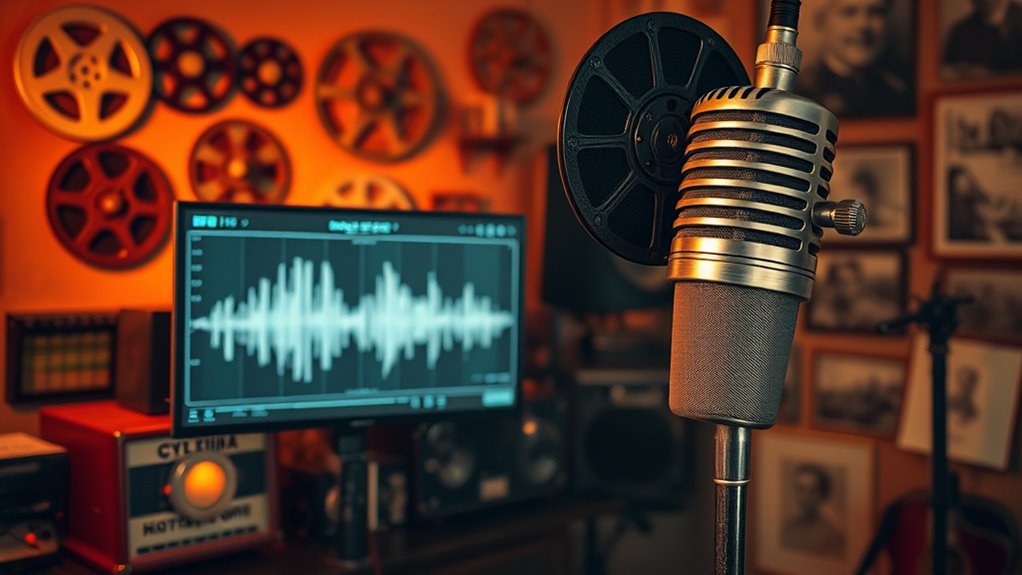
The evolution of voice cloning technology has been rapid and transformative, driven by advances in machine learning and neural networks. You can now experience remarkably realistic voice synthesis that mimics original voices with impressive accuracy. Machine learning algorithms analyze vast amounts of audio data, enabling systems to learn subtle nuances like tone, pitch, and pacing. This progress allows AI to generate speech that sounds natural and authentic, often indistinguishable from real human voices. Initially, voice cloning was limited and cumbersome, but recent breakthroughs have made it more accessible and efficient. Today, the continuous development of neural networks pushes the boundaries of what voice synthesis can achieve, opening new possibilities for reviving historic commentaries and preserving iconic voices for generations to come. Understanding neural networks has been crucial in advancing the fidelity and versatility of voice cloning systems.
Preserving the Voices of Legendary Commentators
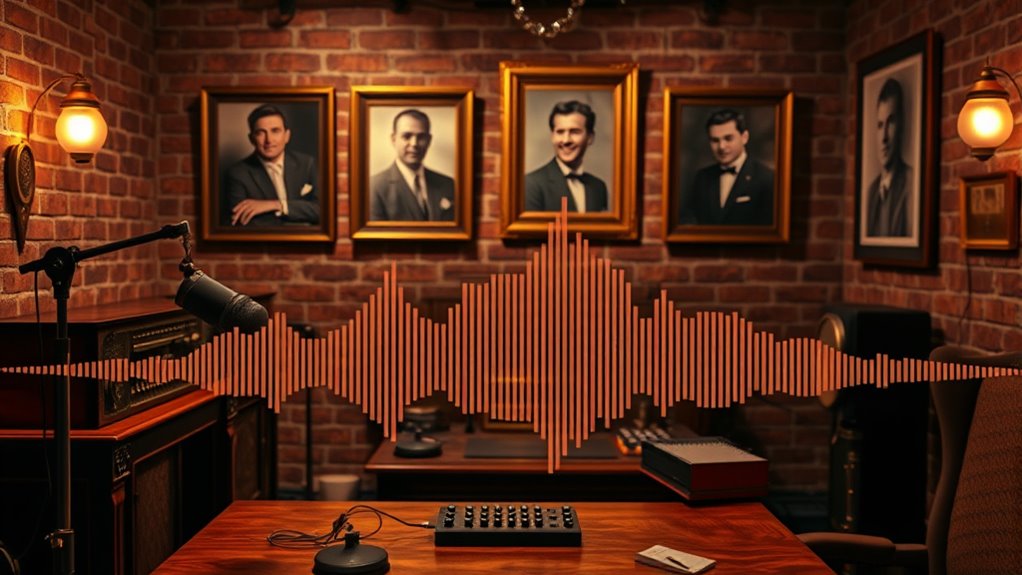
As voice cloning technology advances, preserving the distinct personalities of legendary commentators becomes more achievable than ever. You can now protect voice authenticity through digital archiving, ensuring their iconic voices remain accessible. This process captures the unique tone, style, and nuances that defined their commentary, making it feel genuine even years later. By creating detailed digital archives, you preserve these voices for future generations, allowing their commentary to live on. This approach not only safeguards historical significance but also enables seamless retrieval when needed. Here’s a snapshot of the process:
| Step | Purpose | Outcome |
|---|---|---|
| Recording | Capture authentic voice | High-quality audio files |
| Digitization | Convert to digital format | Easy storage and access |
| Analysis | Identify unique traits | Maintain voice authenticity |
| Cloning | Reproduce voice digitally | Lifelong preservation |
| Archiving | Store securely | Long-term accessibility |
Additionally, ongoing advancements in voice analysis further enhance the accuracy and realism of cloned voices.
Recreating Authentic Audio Experiences
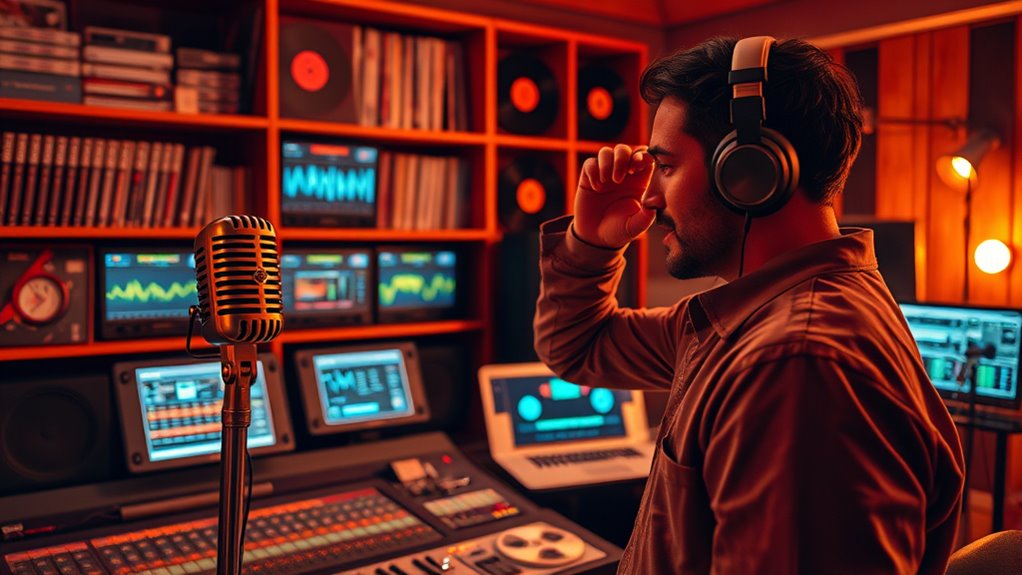
You can experience historic commentaries as if you’re right there, thanks to AI voice cloning that maintains original intonations. These recreations also improve accessibility for those who might otherwise miss out on classic recordings. By reviving lost recordings, you guarantee valuable moments in history remain alive and engaging for all. Additionally, reliable resources ensure the authenticity and ethical use of these recreated voices, fostering trust and preservation.
Preserving Original Intonations
By capturing subtle vocal nuances through AI voice cloning, developers can preserve the original intonations that give historic commentaries their authentic feel. This technology guarantees voice authenticity by maintaining the unique tonal qualities that speakers used, even centuries ago. Tonal fidelity is essential here, as it replicates the pitch, rhythm, and emotional inflections that bring recordings to life. When you preserve these elements, listeners experience a more genuine connection to the past, hearing voices as they originally sounded. AI-driven methods analyze vocal patterns to replicate intonations accurately, avoiding flat or artificial reproductions. This careful attention to tonal details helps maintain the integrity of historic recordings, offering future generations an immersive, faithful audio experience that honors the original speakers’ intent. Additionally, cybersecurity vulnerabilities should be considered when deploying such advanced technologies to ensure the integrity and protection of the digital audio files.
Enhancing Accessibility Features
Preserving the authentic sound of historic commentaries through AI voice cloning considerably enhances accessibility for diverse audiences. By recreating original voices, you can provide immersive experiences for visually impaired or hearing-impaired listeners, making history more inclusive. However, voice privacy becomes a key concern—ensuring the cloned voices are used ethically and with proper consent is essential. Without clear guidelines, legal implications could arise from unauthorized use or misrepresentation. You must navigate these issues carefully to respect the rights of original voice owners and avoid misuse. When done responsibly, AI voice cloning transforms how people engage with history, breaking down barriers and opening new avenues for education and enjoyment.
Reviving Lost Recordings
Reviving lost recordings with AI voice cloning allows us to recreate authentic audio experiences that were previously thought to be gone forever. Through advanced digital archiving, old recordings are preserved and organized, making them accessible for restoration. AI-driven audio restoration techniques clean and enhance degraded sounds, reducing noise and restoring clarity. By applying voice cloning, you can accurately replicate the original speaker’s tone and intonation, breathing new life into historic recordings. This technology bridges gaps in audio history, enabling you to experience moments from the past as if they were happening now. Whether for educational, cultural, or entertainment purposes, reviving these recordings offers a powerful way to preserve and share our audio heritage with modern audiences. Moreover, understanding the role of inspirational quotes in shaping perceptions can deepen our appreciation for these restored voices, connecting us emotionally to the past.
Enhancing Cultural and Sports Heritage
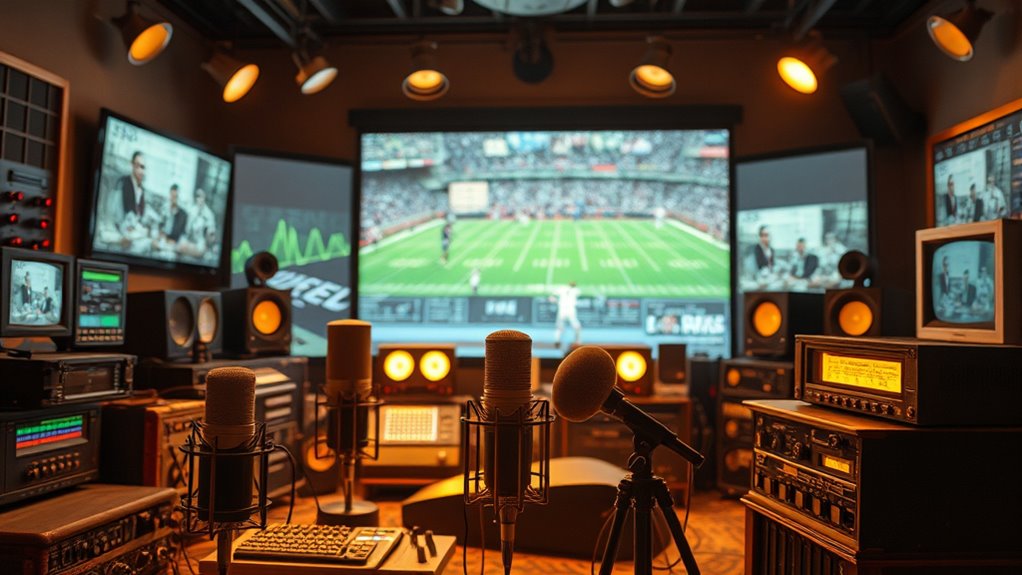
AI voice cloning transforms how we experience cultural and sports heritage by making historic commentary accessible and engaging. It breathes new life into legendary voices, helping preserve cultural heritage for future generations. You can now listen to iconic commentators describing historic events, boosting audience engagement and emotional connection. To deepen this impact, consider: 1. Digitally restoring and preserving rare recordings for wider access. 2. Creating immersive experiences that blend audio with visuals for museums and stadiums. 3. Personalizing content to suit diverse audiences, enhancing cultural preservation efforts. Additionally, digital preservation techniques play a crucial role in safeguarding these recordings for the future. This technology not only revitalizes historic narratives but also strengthens community bonds by making history more relatable and alive. As a result, cultural preservation becomes more dynamic, ensuring that these stories resonate and inspire new generations.
Ethical Considerations in Voice Replication
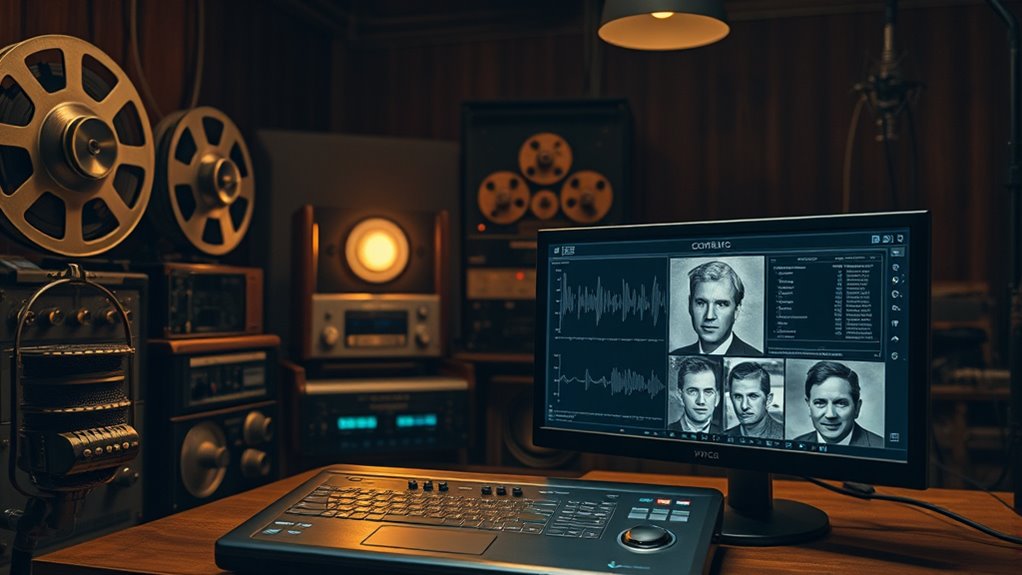
As voice replication technology advances, it raises important ethical questions about consent, authenticity, and potential misuse. You need to consider privacy concerns, especially when recreating voices without explicit permission. If someone’s voice is cloned without their knowledge, it infringes on their privacy and can lead to identity theft or reputational harm. Consent issues are essential; using a voice ethically means obtaining clear permission before generating or sharing the audio. Without proper safeguards, AI voice cloning could be exploited for deception, misinformation, or malicious purposes. As you develop or deploy this technology, it’s critical to establish ethical standards that respect individual rights and prevent abuse. Implementing proper security protocols can help safeguard against unauthorized voice replication. Balancing innovation with responsibility ensures voice replication benefits society without compromising personal privacy or integrity.
Impact on Historical Education and Engagement
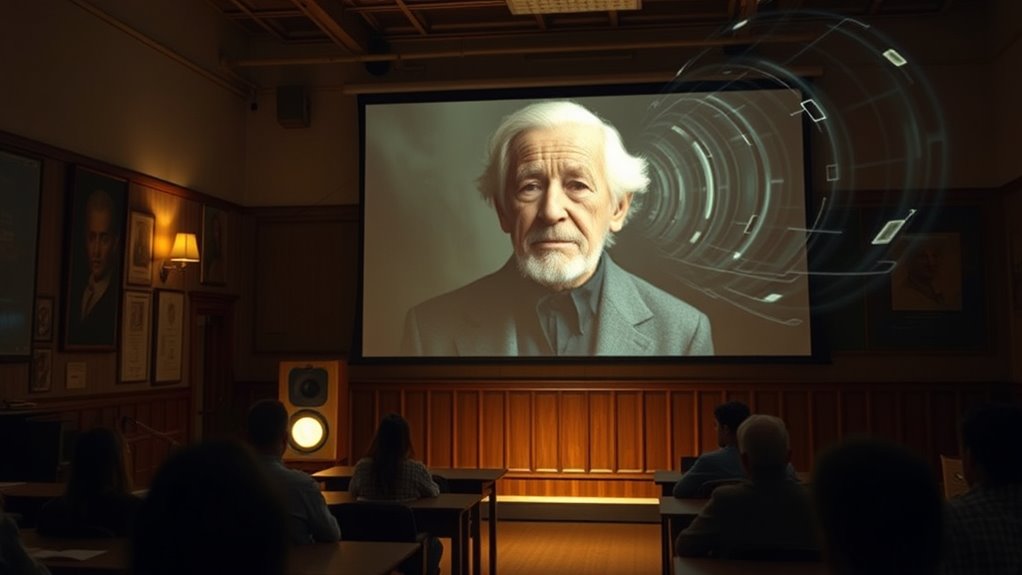
The ethical considerations surrounding voice replication also influence how we can use this technology to enhance historical education and engagement. Voice impersonation brings history to life, making stories more vivid and memorable. However, audio deepfakes can blur the line between fact and fiction, risking misinformation. To maximize benefits, consider these points:
Responsible voice replication enhances history, but must be used ethically to prevent misinformation and preserve authenticity.
- Use voice impersonation responsibly to preserve historical accuracy.
- Educate audiences on distinguishing genuine recordings from manipulated audio deepfakes.
- Implement strict guidelines to guarantee ethical use, preventing misuse or misrepresentation.
- Incorporate auditory authenticity measures to ensure that reconstructed voices accurately reflect the original speakers’ tones and contexts.
Challenges and Limitations of AI Voice Cloning
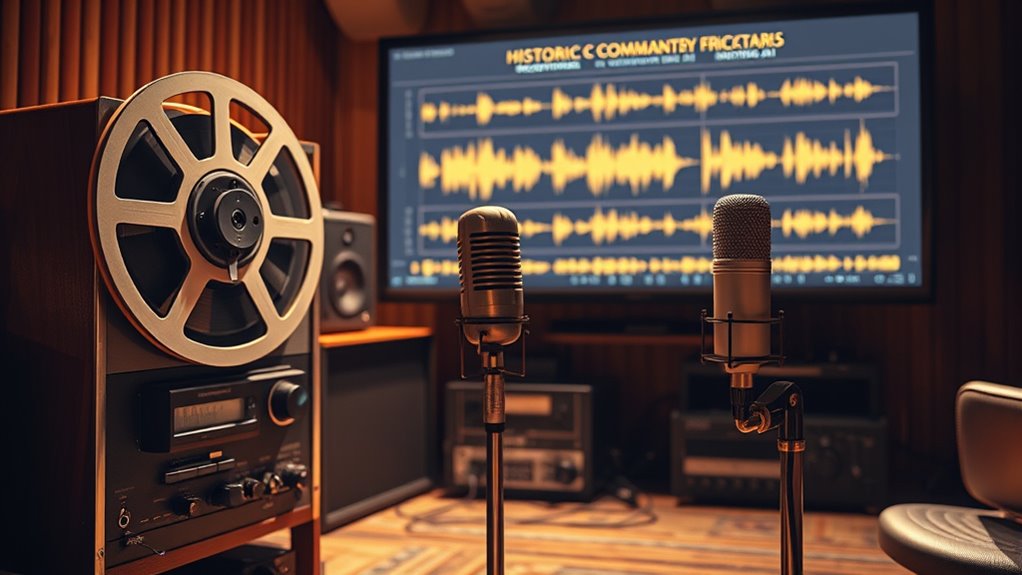
While voice cloning technology has advanced rapidly, it still faces significant challenges that limit its widespread and reliable use. One major issue is voice distortion, which can occur if the AI isn’t trained with high-quality data or if algorithms struggle with nuances in tone and emotion. This distortion can make the cloned voice sound unnatural or inconsistent, reducing authenticity. Additionally, data privacy concerns pose a serious obstacle. Protecting the sensitive recordings used for cloning is vital, but many projects risk exposing personal or proprietary information. Without strict privacy measures, you risk legal and ethical issues. These challenges highlight that, despite impressive progress, AI voice cloning still requires careful refinement and safeguards before it can fully replace or augment traditional methods of preserving historic commentaries. Ensuring high-quality data and ethical standards are maintained is essential for advancing the technology responsibly.
Future Prospects for Reviving Historic Commentaries
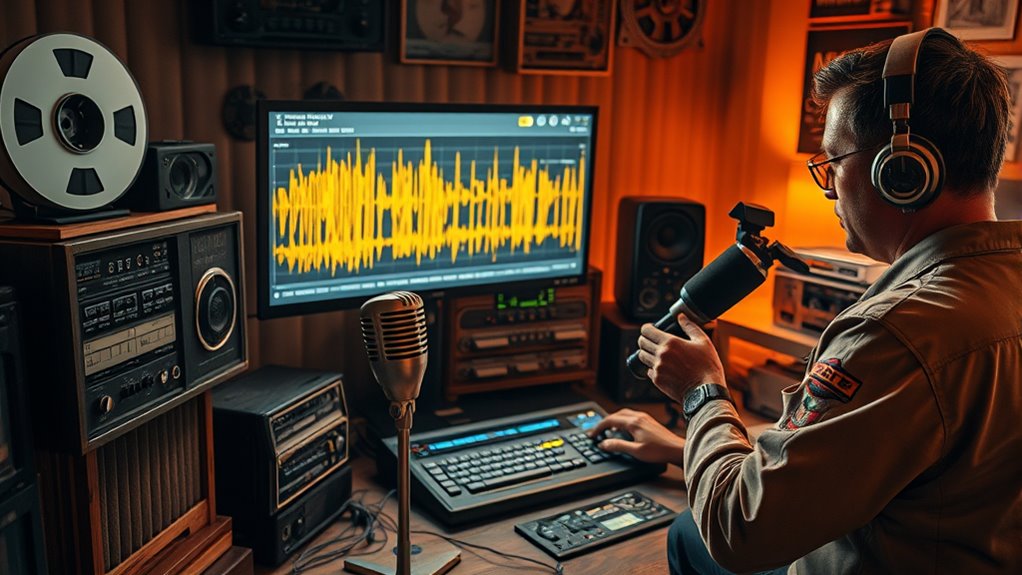
Advances in preservation techniques will make it easier for you to maintain and share historic commentaries for future generations. As accessibility expands, more people can experience these voices and insights firsthand. This progress opens new opportunities to keep history alive and engaging for everyone. Additionally, leveraging financial analysis can ensure proper funding and resource allocation for preservation projects.
Enhanced Preservation Techniques
Emerging preservation techniques powered by AI voice cloning promise to revolutionize how you revive and maintain historic commentaries. These methods focus on ensuring voice authenticity, so reconstructed voices sound natural and true to the original. They also prioritize data privacy, protecting sensitive recordings from misuse. To achieve this, you can implement:
- Advanced encryption for storing voice data, safeguarding privacy.
- AI-driven algorithms that refine voice authenticity with minimal distortion.
- Regular audits to verify data security and prevent unauthorized access.
These techniques allow you to preserve the tone and nuance of historic voices while maintaining strict data privacy standards. As a result, you can confidently restore commentaries for future generations, ensuring their historical integrity remains intact.
Expanding Accessibility Opportunities
As AI voice cloning technology continues to improve, it opens new doors for making historic commentaries more accessible to diverse audiences. By enhancing voice authenticity, these technologies create lifelike narrations that resonate with listeners, making history feel real and personal. You can now experience commentaries in multiple languages or dialects, breaking down language barriers and broadening reach. This accessibility encourages greater user engagement, as audiences connect more deeply with content delivered in familiar or relatable voices. Additionally, AI-powered tools enable personalized learning experiences, catering to different age groups or learning styles. Ultimately, expanding accessibility opportunities ensures that everyone can explore and learn from historic commentaries, fostering a richer understanding of history across cultures and communities.
How This Innovation Connects Past and Present

By enabling voices from the past to speak again with remarkable accuracy, AI voice cloning bridges the gap between history and modern technology. This innovation enhances audience engagement by making historic commentaries more immersive and personal. It also exemplifies technological integration, blending AI with audio preservation to create authentic experiences. To deepen this connection, consider:
- Reviving historical figures’ voices for educational programs.
- Using realistic voice re-creations to enrich museum exhibits.
- Creating interactive experiences that allow audiences to converse with historical personalities.
These applications make history tangible, fostering a stronger emotional connection. As a result, you can explore the past more vividly, ensuring that historic voices remain relevant and impactful in today’s digital age.
Frequently Asked Questions
How Accurate Is AI Voice Cloning in Replicating Original Commentator Nuances?
You might wonder how accurate AI voice cloning is at replicating original commentator nuances. It generally offers impressive voice fidelity, capturing unique tone, pitch, and speech patterns. However, nuance preservation can vary; subtle emotional cues or regional accents may sometimes be less precise. While technology continues to improve, some fine details still challenge AI’s ability to fully mimic the authentic nuance of the original voice.
What Are the Potential Legal Issues Surrounding Voice Cloning of Historic Figures?
You should consider the legal issues of voice cloning historic figures, especially around intellectual property rights and consent requirements. Cloning a voice without permission could infringe on rights or violate consent, leading to lawsuits or legal action. Always verify you respect intellectual property laws and obtain necessary approvals to avoid infringing on rights, and recognize that legal boundaries vary depending on jurisdiction and how the cloned voice is used.
Can AI Replicate Emotional Expression in Recreating Historic Commentaries?
You might wonder if AI can truly replicate emotional expression in historic commentaries. While AI can mimic vocal patterns, achieving genuine emotional depth and musical authenticity remains challenging. It can evoke feelings, but often lacks the nuanced subtlety of human emotion. Still, advancements are improving, allowing AI to produce more convincing emotional responses. This technology offers a fascinating blend of innovation and artistry, bringing historic voices to life with increasing realism.
How Does Voice Cloning Impact the Livelihoods of Professional Voice Artists?
Imagine a voice artist losing a gig because a company uses AI voice cloning instead. You might see voice artist employment decline as industry disruption grows, replacing human voices with AI-generated ones. While some artists adapt by offering unique, personalized services, others face fewer opportunities. This shift challenges traditional roles and prompts the industry to rethink how voice talent is valued, pushing artists to innovate or risk obsolescence.
What Measures Ensure Ethical Use of AI in Reviving Historic Voices?
You should prioritize ethical AI use by implementing strict privacy measures and clear consent protocols. This means obtaining explicit permission before cloning any voice, respecting privacy concerns, and ensuring data security. Establishing transparent guidelines helps prevent misuse and maintains public trust. By actively regulating these practices, you protect historic voices’ integrity and honor the individuals behind them, fostering responsible innovation that benefits everyone involved.
Conclusion
As you explore this frontier, AI voice cloning acts as a bridge across time, resurrecting the voices that once echoed through stadiums and studios. It’s like breathing new life into fading echoes, transforming them into vibrant conversations between eras. This innovation doesn’t just preserve history; it stitches the past and present into a seamless symphony. With every reconstructed commentary, you become part of a timeless tapestry, where memories resonate and stories endure beyond the sands of time.
